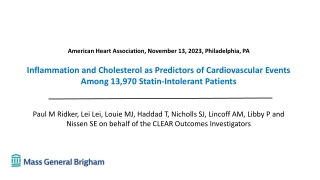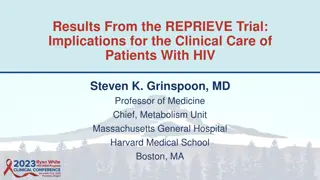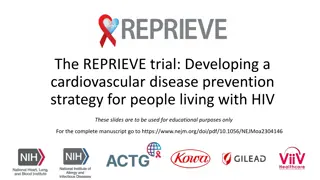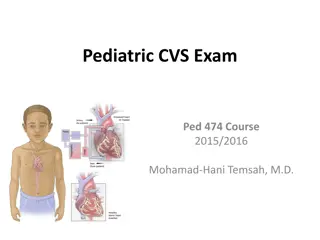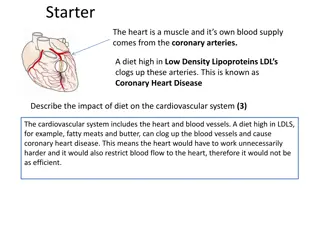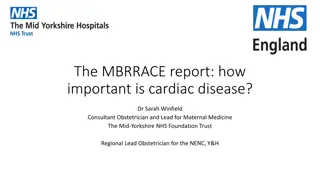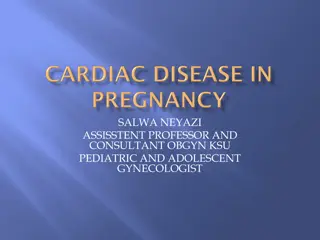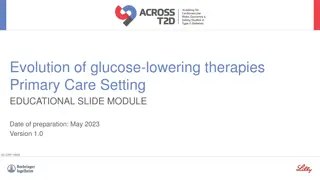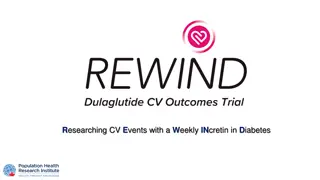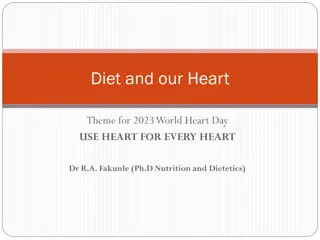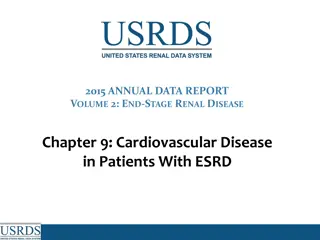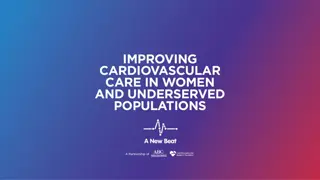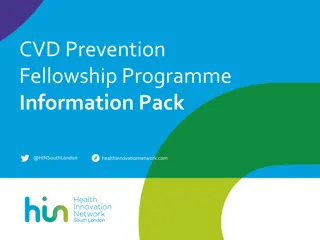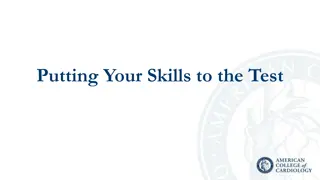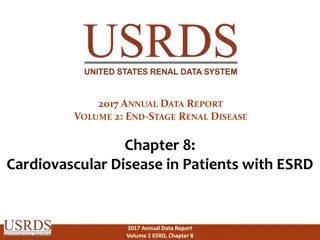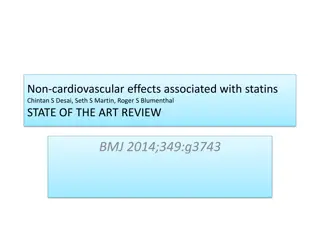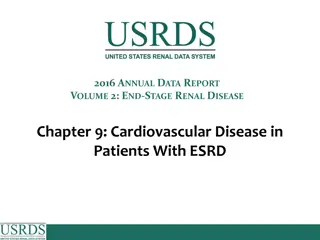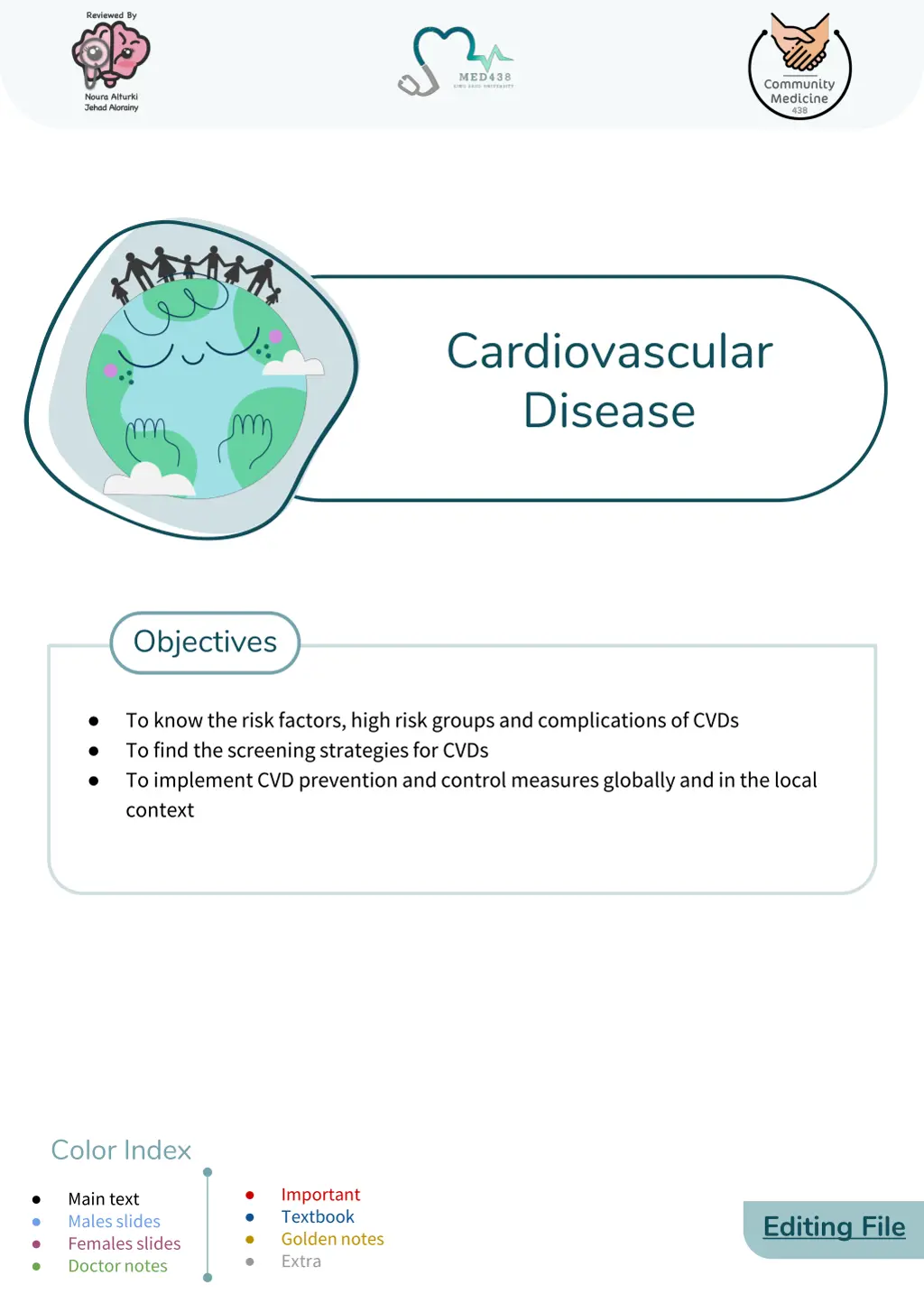
Understanding Cardiovascular Disease: Risk Factors, Complications, Prevention
Explore the risk factors, high-risk groups, complications, and prevention strategies for cardiovascular diseases (CVDs) including coronary heart disease, cerebrovascular disease, and peripheral arterial disease. Learn about modifiable and contributing risk factors such as age, gender, smoking, high cholesterol, and high blood pressure, and discover how to implement global and local prevention measures effectively.
Download Presentation

Please find below an Image/Link to download the presentation.
The content on the website is provided AS IS for your information and personal use only. It may not be sold, licensed, or shared on other websites without obtaining consent from the author. If you encounter any issues during the download, it is possible that the publisher has removed the file from their server.
You are allowed to download the files provided on this website for personal or commercial use, subject to the condition that they are used lawfully. All files are the property of their respective owners.
The content on the website is provided AS IS for your information and personal use only. It may not be sold, licensed, or shared on other websites without obtaining consent from the author.
E N D
Presentation Transcript
Cardiovascular Disease Objectives To know the risk factors, high risk groups and complications of CVDs To find the screening strategies for CVDs To implement CVD prevention and control measures globally and in the local context Color Index Important Textbook Golden notes Extra Main text Males slides Females slides Doctor notes Editing File
Cardiovascular Disease Definition: Cardiovascular disease (CVD) is a group of disorders of the heart and blood vessels, and may include: Coronary heart Disease (CHD): manifested by myocardial infarction (MI), angina pectoris, heart failure, and coronary death. Cerebrovascular Disease: manifested by stroke and transient ischemic attack. Peripheral Arterial Disease (PAD): manifested by intermittent claudications. Aortic Atherosclerosis, Thoracic or Abdominal Aortic Aneurysm CVD Risk Factors Cardiovascular Disease Risk Factors 1. 2. Major risk factors: factors that significantly increase the risk of heart and blood vessel disease. Modifiable risk factors: Some major risk factors can be modified, treated or controlled through medications or lifestyle change. Contributing risk factors: factors associated with increased risk of cardiovascular disease, but their significance and prevalence haven t yet been determined. 3. Type Risk Description Age Men > 45 and Females >55 (majority of people who die are above 65) Gender (male) Men have a greater and earlier risk of heart attack than women do Major Children of parents with heart disease are more likely to develop heart disease themselves. Family history of a premature MI - Defined as MI before age 55 years in men and 65 years in women Heredity (including race)
CVD Risk Factors Cardiovascular Disease Risk Factors Type Risk Description The risk that smokers will develop coronary heart disease is much higher than that for nonsmokers. Cigarette smoking is a powerful independent risk factor for sudden cardiac death in patients with coronary heart disease. Causing: - Mechanical damage of endothelium and atherosclerosis. - Increase coagulability state as increase in fibrinogen level. - Polycythaemia ( RBCs and Hb) and so increase blood viscosity. - Increase LDL, decrease HDL and increase triglycerides. Tobacco There are 3 major types of blood lipids, which are: Low-density-lipoprotein (LDL) cholesterol= bad cholesterol - A low LDL-C level is considered good. Lifestyle factors, such as a diet high in saturated and trans fats (worst), can raise LDL-C. High-density-lipoprotein (HDL) cholesterol= good cholesterol - Higher levels are typically better. Low HDL cholesterol increases risk of heart disease. Genetic factors, Type 2 diabetes, smoking, being overweight and being sedentary can all result in lower HDL cholesterol. Triglycerides - Triglycerides are the most common type of fat in the body. A high triglyceride level combined with low HDL cholesterol or high LDL cholesterol is associated with atherosclerosis, which is the buildup of fatty deposits inside artery walls that increases the risk for CVD. High Cholesterol Modifiable High blood pressure increases the heart s workload, causing the heart muscle to thicken and become stiffer. The Framingham study showed the relative importance of SBP, DBP & pulse pressure (SBP-DBP) changes with age Causing: Mechanical damage of endothelium and atherosclerosis When high blood pressure is present alongside obesity, smoking, high blood cholesterol levels or diabetes, the risk of heart attack or stroke increases even more. In patients <50 years of age, - Diastolic BP was the strongest predictor of CHD risk. - Diastolic pressure increases with age but peaks between 55-60 then decreases. In patients 60 years of age, - Systolic pressure (pulse pressure) was the strongest predictor. - Systolic pressure increases with age - Isolated systolic hypertensionare major CHD risk factors at all ages and in both genders. High Blood Pressure What causes of elevated systolic and lower diastolic pressure with aging? - Arterial stiffening
CVD Risk Factors Cardiovascular Disease Risk Factors Type Risk Description An inactive lifestyle is a risk factor for coronary heart disease. Regular, moderate to vigorous physical activity helps reduce the risk of cardiovascular disease. Physical activity can help control blood cholesterol, diabetes and obesity. It can also help to lower blood pressure in some people. Physical Inactivity Excess body fat is a risk factor to develop heart disease and stroke - Especially if a lot of it is at the waist (central obesity) Even if a person have no other risk factors, obesity alone is considered a major contributing factor Modifiable Obesity What is the best test to assess CV risk in an obese individual? - Waist circumference or waist hip ratio Diabetes seriously increases your risk of developing CVD. Even when glucose levels are under control, diabetes increases the risk of heart disease and stroke. The risks are even greater if blood sugar is not well-controlled. Diabetes Individual response to stress may be a contributing factor for heart attacks. Increase in adrenaline and BP. Stress Drinking too much alcohol can raise blood pressure, and increase your risk for cardiomyopathy, stroke, cancer and other diseases. It can also contribute to high triglycerides, and produce irregular heartbeats. Alcohol Homocystinaemia (more among smokers) High fibrinogen (more among smokers) Prothrombotic markers What are the risk factors for venous thrombosis? - Homocystinaemia and high fibrinogen Contributing High sensitive C-Reactive Protein Proinflammatory markers Microalbuminuria reflects vascular damage and appears to be a marker of early arterial disease. MA is defined as urinary albumin excretion of 30-300 mg/day - It is an indication of increased cardiovascular risk and endothelial dysfunction, and an independent marker for CV morbidity and mortality in individuals with and without diabetes. Microalbuminuria
Screening for CVDs Purpose: The primary purpose of screening for CHD is to identify patients whose prognosis could be improved with an intervention (in this case, medical therapy for risk factors or coronary HD). CHD Screening Vs Risk Estimation Screening for CHD should be distinguished from estimation of risk for CHD (or overall CVD). By definition, both are performed in asymptomatic persons, and both aim to improve outcomes with interventions, if indicated. However, screening for CHD identifies existing disease, while estimating the risk of CHD does not directly identify existing disease but rather the likelihood of any future event related to CHD . Screening Recommendation (AHA) We do not screen most asymptomatic adults for CHD. However, American Heart Association recommends nearly all patients aged 20 years or older without established CVD should undergo periodic cardiovascular risk assessment every three to five years. Screening include: LDL and/or HDL Glucose BP Life style - - - - AHA CVD Risk Calculator (2013) If the calculated CVD risk is 7.5% it is considered high Case: A 63 year old man, known case of HTN, On medication. No H/O DM or smoking. Risk assessment was done. CVD 10 year risk score is >7.5% (13.45% = High) Why? - Due to his age, gender and HTN Case: A 48 year old man, known case of HTN, DM and smoker. 10 year risk score is shown. CVD 10 year risk score is >7.5% (21.87% = High) - This patient should receive high intensity statin, aspirin and should quit smoking If this patient quits smoking and has a (N) HDL, what will happen to his CVD risk? - It will drop to 7.05%
Promoting CV Health Metrics AHA: The American Heart Association listed programs that promote seven ideal cardiovascular health metrics, which include: 1 Not smoking 5 Having a normal total cholesterol level 2 Becoming physically active 6 Having a normal body weight 3 Having a normal blood pressure 7 Eating a healthy diet 4 Having a normal blood glucose Counselling a Patient with High CVD Risk 1 Start by estimating the risk of CVD 2 Ask about family history of premature CVD - Defined as MI before age 55 years in men and 65 years in women ALWAYS consider lifestyle modification - Including smoking cessation, increase in physical activity and improvement of diet. All of these are of proven benefit and should be a primary prevention for all 3 Smoking Cessation Always ask about history of smoking If smoker, always offer counselling to quit smoking Encourage Exercise Moderate degree (like brisk walking for at least 150 mins/wk) is protective against CHD and all- cause mortality. Exercise can elevate serum HDL, reduce BP, decrease insulin resistance and promote weight loss. Men who engaged in moderate sports activity reported 23% lower risk of death. Healthy Diet Fruits and vegetables consumption is inversely related to the risk of CHD and stroke. Higher intake of red meat and high-fat dairy products was associated with higher risk of CVD. High fiber intake is associated with lower risk of CVD when compared to low fiber intake.
Counselling a Patient with High CVD Risk 4 Controlling Comorbidities: - Control BP - Control DM - Reduce weight among obese and overweight people 5 Use of Statins - It is reasonable to start statin therapy in patients whose 10-year risk of CVD 7.5% - Statins lower the risk of death by 15-20% and lower the risk of nonfatal CV events by even greater degrees - The reduction in major CV events is related to the absolute reduction in C-LDL Use of Antiplatelet Therapy - For patients with established and stable atherosclerotic CVD, aspirin is recommended. - Long-term antiplatelet therapy with aspirin reduces the risk of subsequent myocardial infarction (MI), stroke, and cardiovascular death among patients with a wide range of manifestations of occlusive CVD. - In patients who are unable to take aspirin and in those with a history of gastrointestinal bleeding, clopidogrel is a reasonable alternative. 6 7 Use of Antioxidant Vitamins (C and E) - Antioxidant vitamins, the randomized evidence has not demonstrated clinical benefits on CVD in secondary or primary prevention regarding vitamin E and or vitamin C. Conclusion 1 Major risk factors for CVD include age, gender, smoking, hypertension, dyslipidemia, diabetes mellitus obesity, family history of premature CVD. 2 Contributing risk factors for CVD include homocysteinemia, high fibrinogen, high CRP and microalbuminuria. 3 To prevent CVD we need to deal with the risk factors and more importantly life-style modification
Dr. Quiz MCQ 1-A 45-year-old male attends clinic concerned about heart disease. Which of the following is the most important risk factor for determining ischemic heart disease (IHD)? A-A blood pressure of 136/82 mmHg B-A BMI of 31.2 kg/m2 C-A father having died of MI at 50 years of age D-A waist circumference of 88 cm 2-You are in a PHC Center and asked to advise a group of people to reduce the risk from dieting habits. Which one of the following are you going to advise to be avoided? A-Fatty fish B-Protein C-Polyunsaturated fat D-Trans fat 3-Which of the following is the most likely factor to increase the risk of CVD in overweight men? A-Body mass index of 31 B-Increased waist to hip ratio C-Increased weight due to recurrent hypoglycemia D-Skin fold thickness > 20 mm 4-Age is considered one of the non-modifiable risk factors. What is the most appropriate cause of increasing risk regarding age? A-Increased heart rate B-Increased incidence of DM C-Increased arterial stiffening D-Increased adrenaline secretion 5-Which of the following risk factors increase risk of venous thrombosis? A-Homocysteinemia B-Hypertriglyceridemia C-High C-LDL D-High C-VLDL Q1 Q2 Q3 Q4 Q5 Answers C D B C A
Dr. Quiz MCQ 6-How could you advise a person regarding exercise? A-To do a brisk walking for at least 150 mins/wk B-To do a brisk walking for at least 250 mins/wk C-To run for at least 120 mins/wk D-To walk daily for 24 mins 7-A 32-year-old male attends clinic concerned about heart disease as his father died recently from a heart attack at the age of 49. His BMI is 31, waist circumference is 97 cm and BP is 140/87. Which of the following risk factors contribute the most towards his CVD risk? A-Obesity B-Family history C-Blood pressure D-Waist circumference 8-A 66-year-old man, presents to the OHC clinic on 3 occasions because of raised blood pressure. The average blood pressure reading is 176/78. He is non-smoker. His BMI is 30.3. Lab results showed: - FPG 6.2 mmol/L - Total Cholesterol 4.82 mmol/L - Triglyceride 2.13 mmol/L Regarding his management, which of the following factors contribute the most towards his CVD risk? (Normal <5.5 mmol/L) (Normal <5.2 mmol/L) (Normal <1.7 mmol/L) A-Obesity B-Pulse pressure C-TG level D-Impaired fasting glucose (IFG) 9-A 58-year-old man who is hypertensive and asks about reducing his risk of heart attack. You requested a lipid profile and found that the HDL level was 28 mg/dl (Normal >40 mg/dl). Which of the following is an important recommendation to raise HDL lelvel? A-Aspirin B-Regular exercise C-Low cholesterol diet D-Vit D (800 U/day) 10-Smoking is a major risk factor for CVD through some mechanisms. Which one of the following could be due to smoking? A-Decrease fibrinogen level and increase LDL B-Decrease HDL level and increase TG and LDL C-Decrease TG and increase homocysteine D-Decrease RBCs count level and increase Hg Q6 Q7 Q8 Q9 Q10 Answers A B B B B
Dr. Quiz MCQ 11-A 58-year-old male attends you clinic for clinical checkup and control of his high BP. You applied the 10 year risk for CVD and calculated it. Which of the following is the cutoff to consider a person high risk? A- 5% B- 7.5% C- 10% D- 12.5% 12- Smoking is a major risk factor for CVD through some mechanisms. Which one of the following could be due to smoking? A-Decrease homocysteine and increase fibrinogen B-Decrease LDL level and increase HDL C-Decrease TG and increase homocysteine D-Increase RBCs count level and increase hemoglobin 13-A patient was admitted to the hospital for regular checkup. His CRP was 18 mg/L. Which of the following is the correct explanation of CRP contributing risk factor for CVD to the patient? A-Low risk B-Moderate risk C-High risk D-This value should be neglected in terms of CVD risk 14-Which of the following is a major modifiable risk factor to CVD? A-Alcohol B-Microalbuminuria C-Stress D-Tobacco smoking 15-Which of the following is a risk factor for increasing fibrinogen level and leading to venous thrombosis? A-DM B-Obesity C-Alcohol D-Tobacco smoking Q11 Q12 Q13 Q14 Q15 Answers B D D D D
Thank You and Good Luck Team Leaders: Lama AlAssiri | Mohammed AlHuqbani | Ibrahim AlDakhil Team Members: Sara AlAbdulkareem Deema AlMaziad Hameed M. Humaid Sedra Elsirawani Lama AlZamil Khalid Alkhani Wejdan Alnufaie Leen AlMazroa Meshari Alzeer Abdulrahman Alhawas Lina AlOsaimi Mohannad Makkawi Abdulrahman Shadid Muneera AlKhorayef Nayef Alsaber Abdullah Aldawood Norah AlHarbi Omar Aldosari Abdullah Shadid Norah AlMazrou Omar Alghadir Alwaleed Alsaleh Nouf Alhussaini Zyad Aldosari Bader Alshehri Razan AlRabah Bassam Alkhuwaiter Renad Alhaqbani Faisal Alqifari Rema AlMutawa

